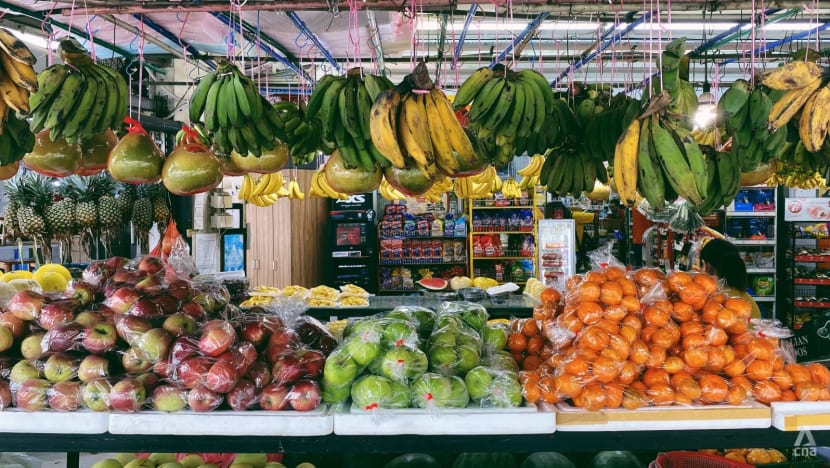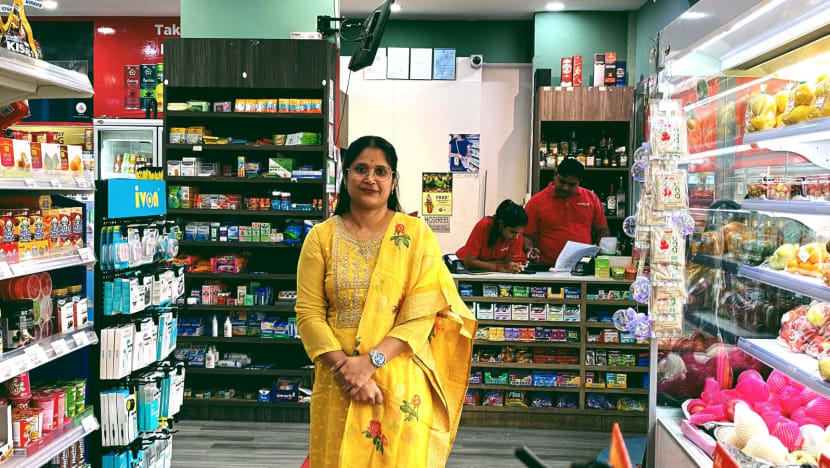'Very painful': When the rising cost of living trickles down to the average minimart
How does a five-cent price increase impact a minimart? What happens when a supermarket nearby prices the same item at 10 cents less? And how does shoplifting affect the bottom line? CNA hears from minimart owners about what it takes to run their business.

Mr Alvin Tan runs Kim Eng Mini Supermarket at Yishun. (Photo: CNA/Grace Yeoh)

This audio is generated by an AI tool.
SINGAPORE: About nine years ago, Mr Alvin Tan fulfilled a childhood dream. He took over his family’s minimart where he grew up.
The 32-year-old manager, a self-professed “very traditional person”, always saw Kim Eng Mini Supermarket as his career's “final destination”. After all, the minimart in Yishun also happens to be named after his grandmother.
But the store has seen better days, with the rising cost of living exacerbating existing challenges like shoplifting and competition with supermarkets. His struggles are not unique, however, with other minimart owners painting a similarly grim picture.
RISING COSTS, DIPPING SALES
The director of Family Needs Minimart at Rangoon Road, Ms Nilima Moniruzzaman, said that with some suppliers’ prices increasing “three to four times” from 2022 to 2023, she faces “no stability”.
In supermarkets, customers usually don’t haggle over the price, the 44-year-old added. But in her minimart, they are “not happy” with a 10-cent increase.
Ms Nilima said the cost of electricity and other utilities have also spiked this year, and the increase has been particularly noticeable with her store open 24 hours.
Meanwhile, Mr Eng Yong An from Martways minimart at Haig Road said he used to fork out at most S$2,000 (US$1,480) a month for utilities. But it has gone up to over S$4,000 a month.
Rent has also risen, said the 46-year-old owner who owns another store at Waterloo Street, pointing out that “if it’s continuously going this way, we might need to give up” one store.

For Mr Tan, the increased cost of individual items is one reason the year has been “very painful” for him.
A 400g tin of sardines illustrates his point. Just a few years ago, he was making a 10 per cent profit margin by selling it at S$3.95 a tin for a bundle of two.
The same tin now sells at FairPrice for S$4.95 each. He sells it at a slightly lower price, S$4.90.
“Our sales volume dropped drastically. I (used to) go through about 10 cartons every two weeks. Right now I go through three cartons within the same timeframe,” he said. “Because people cannot afford. They will go for the smaller size.”
A difference of five cents, too, will result in “a huge pile of stock” left over, added Mr Tan. He said instant coffee brand Old Town used to sell at a “very high” volume, but “suddenly dropped within a month”.
The culprit? A FairPrice nearby selling it at a lower price, he subsequently found out. So he had to match the supermarket's price.
Minimart owners also pointed to a specific item whose sales have dipped: Cigarettes. This follows the rise in excise duty on all tobacco products by 15 per cent since February, which was announced by Finance Minister Lawrence Wong in his Budget speech – a move aimed at snuffing out smoking.
Mr Tan said his minimart sold about 1,000 fewer packs of cigarettes that month compared with sales prior to the announcement and saw a “steady drop” the following month. Since the tax increase, he has seen a fall of “close to 10 per cent” in revenue for cigarettes.
Customers now typically go for lower-priced cigarettes “or don’t smoke at all”, he said.
For Mr Eng, the decrease in cigarette sales has affected the sale of other products.
“They usually buy something else, like drinks ... So if they don’t buy cigarettes, they tend to skip buying other things too. It’s about buying habits,” he said.
Similarly, Ms Nilima noted that even though her biggest profit margin comes from snacks and soft drinks, the bulk of her customers usually “won’t enter” the store if it does not sell cigarettes, liquor or beer. These are typically purchased together with snacks or soft drinks, she said.
LOSSES FROM SHOPLIFTING, DAMAGED GOODS
To add to the rising costs, minimart owners said they also deal with errant customers whose behaviour can range from shoplifting to surreptitiously placing back damaged goods on the shelves.
Mr Tan sees shoplifters typically once a month – but this is only those who are caught. While his store has CCTV cameras and high-value items are placed near the counter, he suggested that a better solution for businesses like his is to “factor in” a sum they could lose due to shoplifting in their monthly expenditure. In his case, this amount comes up to S$2,000.
“As much as we don’t want it to happen ... we aren’t hiring enough staff to plug this gap. So, you might as well budget it as loss in sales,” he reasoned.
When he catches them red-handed, he would rather call the shoplifter’s family than report the incident to the police, he said. The former is about “dignity”; they don't want to get their family members involved so they choose to pay up instead.

Ms Nilima, too, has CCTV cameras at various corners of her store. She also tries to employ more staff to target the “very significant problem” of shoplifters, most of whom attempt to steal beer. Still, she acknowledged that they “cannot monitor every single minute and every single second”.
On the other hand, shoplifting is “not that big” an issue at Mr Eng’s minimart, even though, like Mr Tan, he catches about one shoplifter a month. And he doesn't report the incident if it’s their first time.
There was, however, an elderly man who came back multiple times to steal bread, he recalled. He found out the man lived at a nearby landed property after reporting the case to the authorities, which suggested to him that the shoplifter could afford to pay but perhaps enjoyed the “challenge” of shoplifting.
Mr Eng deals with another problem: Dented cans. Some customers drop canned items "then put it back quietly and take a new one", he said.
"Then new customers won’t want to buy, so either I have to sell it off at a loss or I have to personally buy and use it myself."
In the four years he has owned the minimart, which he bought from the previous owner, he has also come across counterfeit notes twice. He verified the notes with the bank – then wrote off the loss. “What else can we do? We have nobody to claim from,” he said.
LOCATION, DIFFERENTIATING FACTOR
Despite the prevailing challenges, owners are adamant that minimarts have a place in Singapore society because they “supplement” supermarkets, which don’t cover all areas. So, many are ready to fight to keep theirs.
Mr Tan, whose minimart lies within the mature estate of Chong Pang in Yishun, said it is partly due to the elderly who are “unable to travel out of their convenient (zone)” that his store remains standing. That, and a nearby bigger supermarket that shut down.
To help her business stand out, Ms Nilima gets her staff to deliver goods to customers who are living nearby. “Even one item, they will also deliver,” she said. She also stocks up on daily necessities, so “if customers need it in the middle of the night, they can just come and buy”.
With many Singaporeans familiar with supermarkets, success depends on location – which is “very critical” – and creating a differentiating factor, noted Assistant Professor Charlene Chen, a social and consumer psychologist from Nanyang Technological University.
“If you’re lucky, you’re located where there’s not much competition. Strategically, some are close to schools, so kids can drop by after class. If you’re in a location where you have steady flow of clientele and traffic, then you’re protected from bigger external forces.”
The COVID-19 pandemic and rising prices due to inflation, for example, would hit a single minimart harder than a supermarket chain which can “ride over tough patches”, she said.
As such, minimarts that “survive a longer time” may have managed to “plug themselves” into an area not served by a larger supermarket. They have “already established their presence” and are “familiar faces” to residents in the area.
A good location, however, might be insufficient when a supermarket “pops up nearby”, or when they have “supply issues” and customers turn to supermarkets to get certain products, Asst Prof Chen cautioned.
Additionally, minimarts typically do not enjoy large economies of scale like supermarkets, pushing their prices higher. Customers who are on the hunt for cheaper products, as well as greater variety, would turn to supermarkets, she said.
And the “shopping goal is different” for a minimart customer, she added. She visits the provision store in her estate when she wants to “grab a couple of things I’m missing”, including dry goods that the supermarket might not sell.
Supermarkets, on the other hand, tend to have loyalty reward programmes which minimarts don’t, she noted. “If I’m attracted by these prizes and potential gifts, then I might shop at a supermarket.”
Asst Prof Chen nonetheless pointed to “interesting vending machines and pop-ups” that she has spotted at minimarts to attract customers to the store. These “nostalgic” features give people “an incentive to stop by and buy something “that can’t be bought from the supermarket”.
“Whatever business you’re in, it’s important to differentiate yourself from competitors – as long as there’s some kind of footfall,” she said.
While such strategies might be necessary today, first-generation minimart owners who are still in business “earned their first pot of gold” through their minimart, Mr Tan pointed out. “But in this day and age, we’re just managing costs.”
His minimart has been a family business since he was Primary 5 and he "can’t bear" to let it go. In fact, even when he met his wife, he mentally prepared her – he would work here “for (the rest of) my life” unless his parents decide to give up the business.
“I told her I have never given up hope on this business, and I will never give it up unless the situation has to change,” he said.

















